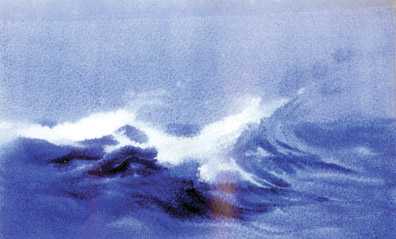
The importance of paper and water
Paper is important when working with watercolour whether the painting
is on a wet or on a dry background. Watercolour paint is transparent and
the paper's texture remains visible.
To paint on a wet background a paper that will not wrinkle easily is
needed. The basis of watercolour painting is water. Water allows the
paint to flow easily over the paper. Therefore, different types of paper
are needed for water colour paintings.
Stretching the paper
|

This painting depicts the whites that have been opened up
|
Before beginning to paint with different watercolour techniques, it
is helpful to learn how to stretch paper over a drawing board. This will
avoid formation of pockets of colours, as well as assure that the wet
paper does not wrinkle. Many artists use painter's tape to stick the
paper to the drawing board.
Any paper can be stretched, but a certain thickness is recommended so
that it does not rip during the process. First wet the paper and wait
for the paper to soak the water. This will not take long, not more than
one or two minutes. While the paper is still wet, stick the four strips
of painter's tape on each side of the paper so that it fastens to the
board.
Wait until the paper is thoroughly dry before beginning to paint. It
is not important if pockets form in the paper while it is wet. They will
most certainly disappear when the paper dries and its surface will be
smooth. Some artists use drawing pins on the four corners of the drawing
board to fix the paper.
Perhaps the drawing pins may become more convenient as you may not
always find the painter's tape in the market. Once the painting is
complete you must wait for it to dry again. Then a ruler or a knife can
be used to cut the painter's tape from the drawing board.
Reducing the wet colour
The colours that the watercolour painter must have will depend on the
use to which he puts them. A person who enjoys painting monocromes, will
not need an extensive range of colours, just the minimum to allow the
tones to be displayed. An extensive range is necessary when the painting
demands unusual colours or colours that are impossible to create with
simple mixtures. To remove paint first, use a dry brush and remove all
the colour that one stroke can soak. Then wash the brush in clean water,
squeeze it out, and repeat the process.
The more often a brush is passed across an area of the paper, the
more the wet background becomes like the white of the paper.
Once the whites have been opened, contrasts can be added to open the
forms which are depicted in this painting. |

